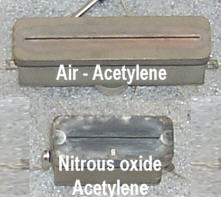

The slot separators in some older Boling burner heads, like that shown here, were made of a copper-zinc alloy that resists low concentrations of acid but decomposes when exposed to high acid concentrations. The baseline drift was caused by zinc leaching from the burner head while a sample, a standard, or the reagent blank was being introduced into the flame. The technician has several options.
 The most reasonable option would
be to switch to a single slot burner head, designed for either
for air-acetylene or for nitrous-oxide acetylene flames. The latter
can be also used with air-acetylene flames when reduced sensitivity
is needed to improve linearity. If these burner heads were not
available, he would have to reconsider his experimental design
and dilute all the samples by a factor of 20 with distilled water
so that the high acid concentration would no longer be present.
Standards would then be prepared in the range from 0.25 to 2 ppm
rather than 5 to 40 ppm. This would require a significantly greater
workload, but there would be no other option. However, if the
technician was lucky and his company had purchased an auto-dilution
device, such as that available from Varian,
Inc., Perkin-Elmer,
Gilson, or other company,
the dilutions could be made online with no significant increase
in analysis time.
The most reasonable option would
be to switch to a single slot burner head, designed for either
for air-acetylene or for nitrous-oxide acetylene flames. The latter
can be also used with air-acetylene flames when reduced sensitivity
is needed to improve linearity. If these burner heads were not
available, he would have to reconsider his experimental design
and dilute all the samples by a factor of 20 with distilled water
so that the high acid concentration would no longer be present.
Standards would then be prepared in the range from 0.25 to 2 ppm
rather than 5 to 40 ppm. This would require a significantly greater
workload, but there would be no other option. However, if the
technician was lucky and his company had purchased an auto-dilution
device, such as that available from Varian,
Inc., Perkin-Elmer,
Gilson, or other company,
the dilutions could be made online with no significant increase
in analysis time.